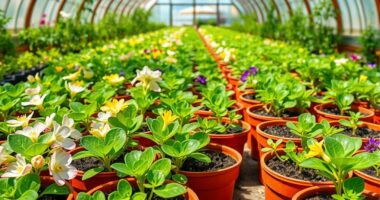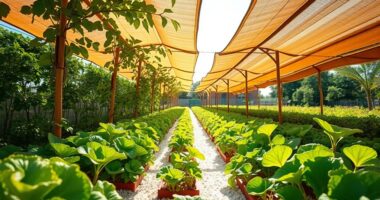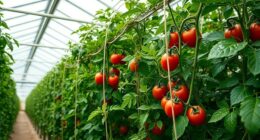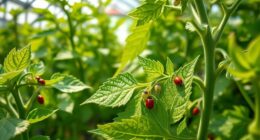To prepare your greenhouse for fall, start by inspecting and cleaning all surfaces, repairing damage, and enriching the soil with compost. Monitor and adjust temperature and humidity levels, using heaters, fans, or shades to prevent cold stress and maintain the ideal environment. Protect plants with frost covers and mulch, and modify lighting schedules to support shorter days. Regular pest control and crop rotation will also boost your crop health. Keep exploring to uncover more tips for a successful autumn harvest.
Key Takeaways
- Conduct a thorough inspection and cleaning of the greenhouse, repairing damage and removing debris to ensure optimal growing conditions.
- Prepare soil by enriching with compost, testing pH, and removing weeds for healthy fall crop growth.
- Adjust ventilation, shading, and lighting to regulate temperature and light levels suitable for autumn plants.
- Implement frost protection measures like row covers, mulch, and supplemental heat to safeguard crops from cold stress.
- Plan crop rotation and harvest schedules to maximize yield and maintain soil health throughout the fall season.
Assess and Clean Your Greenhouse Space
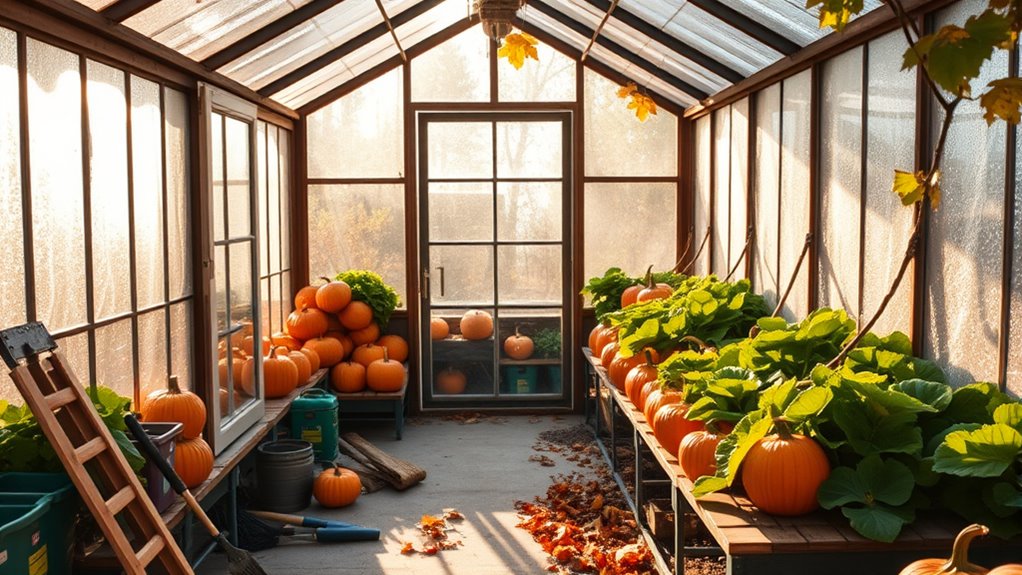
Before preparing your greenhouse for fall, it’s essential to thoroughly assess and clean the space. Start by inspecting the structure for any damage or needed repairs, ensuring your greenhouse accessories are secure and functional. Regular maintenance helps prevent issues during the colder months and keeps your greenhouse in optimal condition. Clear out debris, dead plants, and old soil to prevent pests and diseases from overwintering. Clean the glass or plastic panels to maximize sunlight exposure, which is crucial for your seasonal plant selection. Take time to organize tools, pots, and supplies, making it easier to access what you need later. Consider adding or updating your greenhouse accessories, such as shelving or heating mats, to support your fall crops. Incorporating cultural narratives into your gardening practices can inspire your autumn planting choices and bring a unique touch to your greenhouse environment. A clean, well-organized space provides a healthy environment for your plants and simplifies your autumn gardening efforts.
Optimize Temperature Control and Ventilation
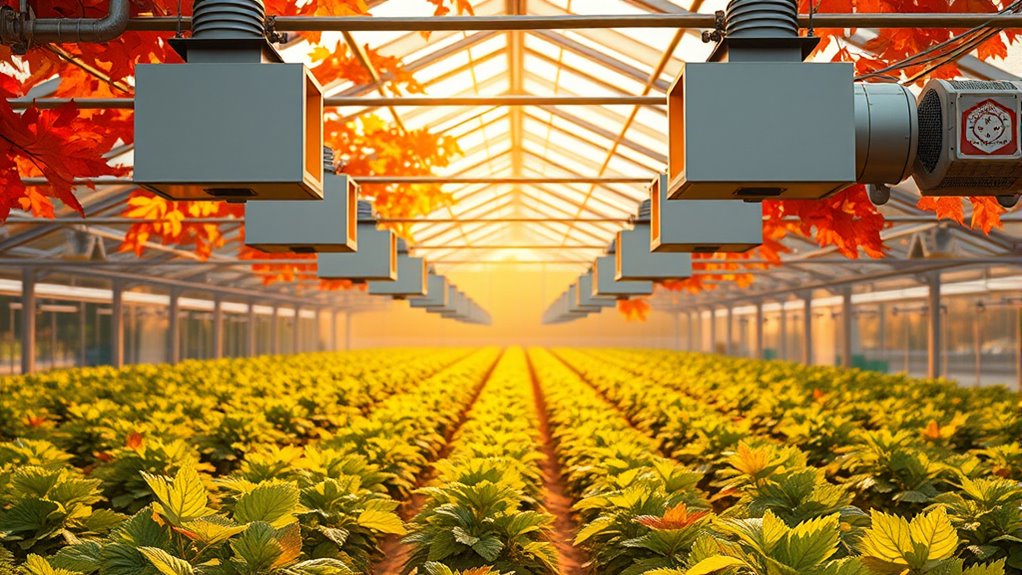
You should adjust your ventilation settings to keep airflow consistent and prevent overheating. Using shade cloths can help reduce excessive sunlight and regulate temperature naturally. Regularly monitoring your greenhouse’s temperature guarantees you catch issues early and make necessary adjustments. Incorporating proper ventilation and air quality management into your management plan is essential to maintain a safe environment for plants and prevent potential hazards. Additionally, advancements in AI-driven solutions can further optimize environmental controls for optimal crop health. Ensuring that your maintenance routines include checking fans and vents regularly can prevent system failures and maintain consistent airflow.
Adjust Ventilation Settings
As outdoor temperatures fluctuate in autumn, adjusting your greenhouse’s ventilation settings becomes essential to maintain ideal growing conditions. Proper ventilation efficiency guarantees consistent airflow patterns, preventing overheating or humidity buildup. You can optimize airflow by opening vents during warm days and closing them when it gets cooler. Use the table below to help you fine-tune your ventilation:
| Temperature Range | Ventilation Action | Notes |
|---|---|---|
| 60-70°F | Moderate ventilation | Maintain steady airflow |
| 70-80°F | Increase ventilation | Prevent overheating |
| Below 60°F | Minimize ventilation | Retain heat, avoid drafts |
Adjustments based on these ranges keep your greenhouse comfortable and healthy for your plants. Proper tuning of your greenhouse environment is crucial for climate control and optimal plant growth. Regularly monitoring performance metrics can help you make timely adjustments and ensure your greenhouse remains a productive space during the autumn season. Incorporating automated ventilation systems can further streamline these adjustments and enhance overall environmental stability. Additionally, monitoring airflow patterns helps you identify areas that need better circulation for uniform temperature and humidity levels.
Use Shade Cloths
Using shade cloths is an effective way to regulate temperature and improve airflow in your greenhouse during autumn. By installing shade cloths, you can block excess sunlight, preventing overheating during warmer days. They help control the amount of light filtration, creating a more stable environment for your plants. Shade cloths also promote better air circulation, reducing humidity and preventing mold or disease. This ventilation boost keeps temperatures consistent and avoids heat stress on your crops. Choose the right density of shade cloths based on your greenhouse’s needs, and secure them properly to withstand autumn winds. Proper installation of shade cloths is crucial to ensure maximum effectiveness and durability. With proper use, shade cloths will help you maintain an ideal growing environment, ensuring your plants stay healthy and productive throughout the fall season. Additionally, integrating ventilation technology can further enhance air circulation and temperature regulation within your greenhouse. Incorporating natural airflow principles by designing openings and vents can also significantly improve overall climate control. Properly managing moisture levels and airflow can further prevent issues such as overwatering, and incorporating lateral airflow fans can improve the distribution of air for a healthier environment for your plants.
Monitor Temperature Regularly
Monitoring temperature regularly is essential to maintaining ideal conditions in your greenhouse during autumn. Consistent checks help you adjust for temperature fluctuations, ensuring plants stay healthy. Use reliable thermometers to track changes and make timely adjustments to ventilation or heating. Proper humidity control is also vital; too much moisture can promote diseases, while too little can stress plants. Additionally, lighting adjustment is crucial as daylight shortens. Use supplemental lighting if needed to maintain growth rates. Regular climate monitoring ensures you can respond promptly to environmental changes, preventing stress or damage to your plants. Consider the following:
| Action | Purpose |
|---|---|
| Ventilation checks | Prevent overheating and control humidity |
| Adjust lighting | Compensate for shorter days |
| Thermometer readings | Guide temperature regulation |
Staying vigilant ensures your greenhouse remains an optimal environment for your fall harvest. Effective climate management is essential for healthy plant growth.
Prepare Soil and Planting Areas for Fall Crops
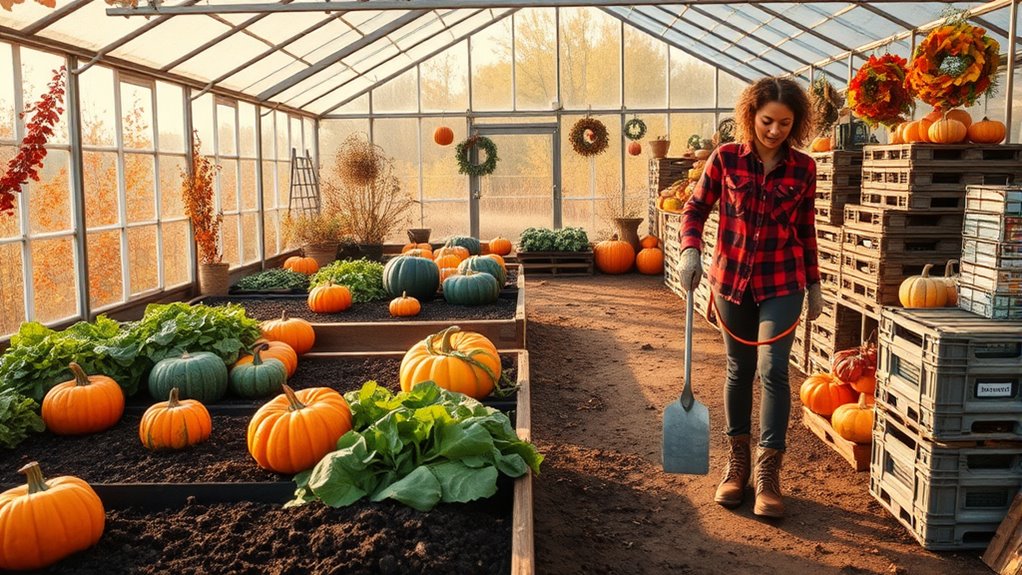
Preparing your soil and planting areas is essential to guarantee a successful fall harvest. Start with compost preparation by enriching your soil with nutrient-rich compost, which improves fertility and drainage.
Conduct soil testing to determine pH levels and nutrient deficiencies; this helps you amend the soil appropriately. Adjust soil acidity or alkalinity as needed to create ideal conditions for fall crops.
Remove any weeds, debris, and old plant material to prevent pests and diseases. Loosen the soil to improve aeration and root penetration.
Incorporate organic matter based on soil test results to ensure your plants have access to essential nutrients. Properly prepared soil boosts plant health, yields, and resilience throughout the fall season.
Being aware of potential cybersecurity threats in your online activities can help protect your data and avoid disruptions. Taking these steps now sets the foundation for a productive harvest.
Protect Plants From Cold Stress and Frost

Once your soil is ready and your planting areas are set, it’s time to focus on safeguarding your plants from the coming cold. Cold protection is essential to prevent damage from low temperatures and frost.
Use row covers or frost blankets to insulate plants during cold nights, trapping heat and shielding them from frost prevention risks. Consider installing outdoor heaters or heat lamps for additional warmth if temperatures drop considerably. Mulching around plant bases also helps retain soil heat and protect roots from freezing.
Keep a close eye on weather forecasts so you can take quick action if a sudden cold snap occurs. Proper cold protection ensures your plants stay healthy and continue thriving throughout autumn, maximizing your harvest potential.
Adjust Lighting to Support Autumn Growth
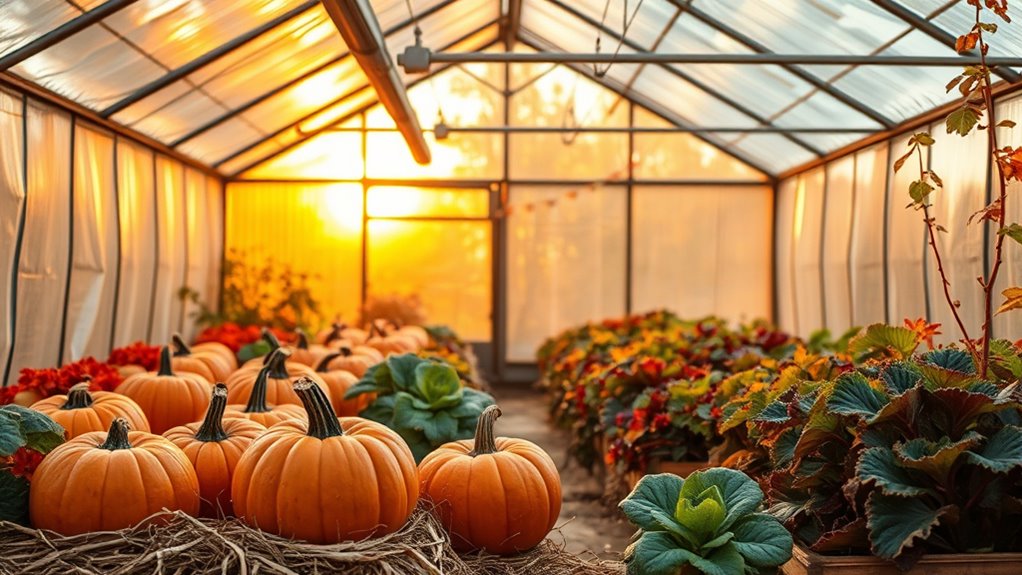
As daylight hours shorten and natural light diminishes during autumn, it’s essential to modify your greenhouse lighting to support healthy plant growth. You should change your lighting schedules to ensure plants receive adequate light for photosynthesis and development. Supplemental illumination can bridge the gap when natural light is insufficient, maintaining consistent growth rates. To optimize your setup, consider the following:
| Time of Day | Lighting Schedule | Recommended Light Intensity |
|---|---|---|
| Morning | 7:00 am – 9:00 am | 200-300 lux |
| Midday | 11:00 am – 2:00 pm | 400-600 lux |
| Evening | 4:00 pm – 6:00 pm | 150-250 lux |
| Night | After sunset | Supplemental illumination |
| Overall | 12-14 hours/day | Consistent light levels |
Adjusting lighting guarantees plants thrive during shorter days.
Implement Pest and Disease Management Strategies
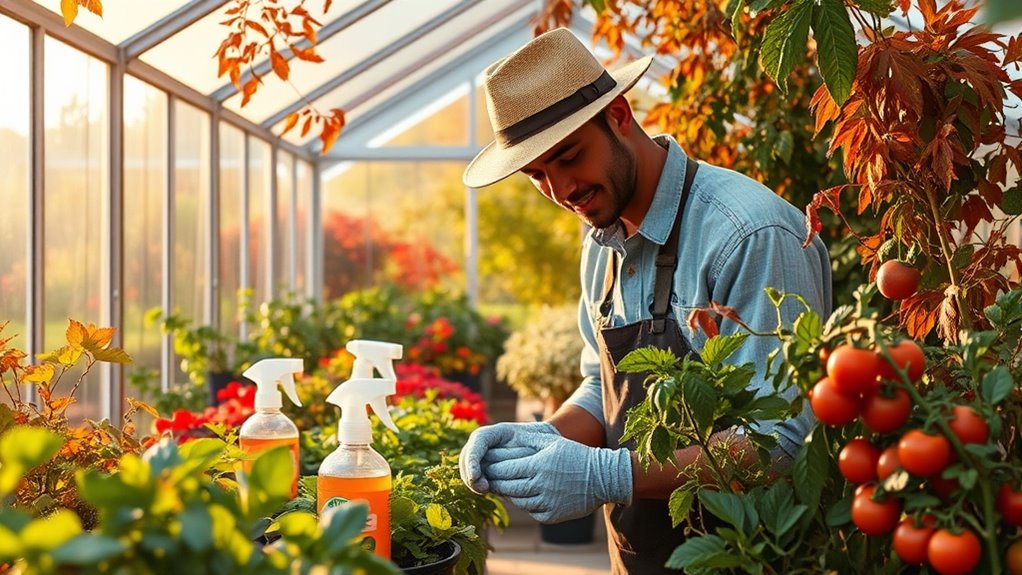
Since pests and diseases can quickly spread as temperatures fluctuate during autumn, it’s crucial to implement effective management strategies in your greenhouse. You should regularly monitor plants for early signs of trouble and act promptly.
Use biological controls like beneficial insects to naturally reduce pest populations. Apply organic sprays such as neem oil or insecticidal soap to target pests and disease-causing organisms without harming your plants.
Keep your greenhouse clean by removing debris and infected plant material to prevent pathogen spread. Ensure proper ventilation to reduce humidity, which discourages mold and fungal issues.
Additionally, quarantine new plants before introducing them to your greenhouse to avoid bringing in pests or diseases. Together, these tactics help maintain a healthy, productive environment during fall.
Plan for Seasonal Crop Rotation and Harvesting
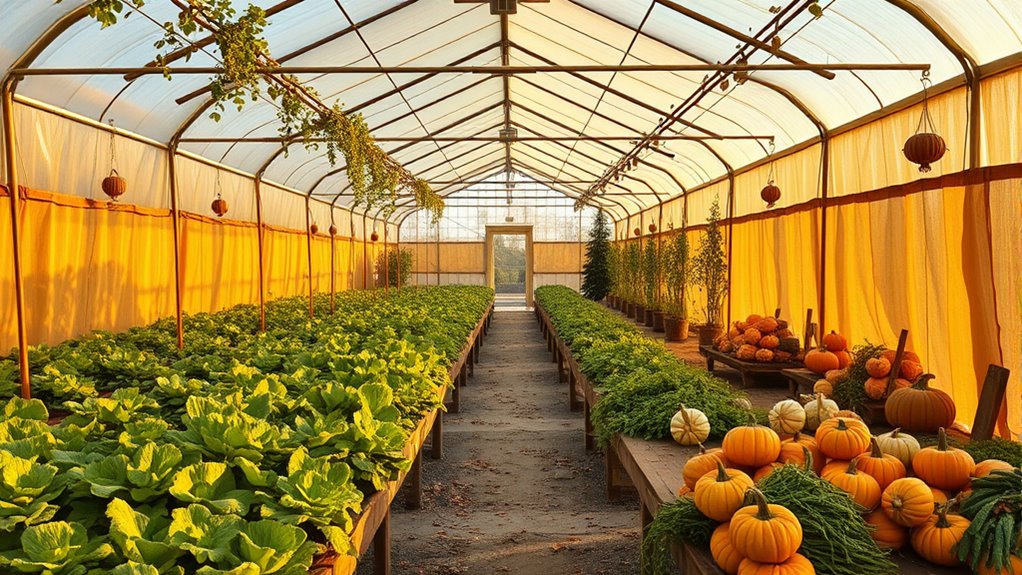
Planning for seasonal crop rotation and harvesting is essential to maintaining a healthy and productive greenhouse throughout autumn. By rotating crops, you prevent soil depletion and reduce pest and disease buildup, promoting crop diversity.
Effective crop rotation in autumn preserves soil health and prevents pests.
Consider planting quick-maturing vegetables like leafy greens first, then shift to root crops or brassicas as the season progresses. This approach optimizes harvest timing, ensuring a steady supply of fresh produce and avoiding overcrowding.
Keep detailed records of planting dates and growth stages to anticipate harvest windows accurately. Adjust your planting schedule based on weather patterns and plant maturity.
Proper crop rotation also helps manage soil health and minimizes the risk of crop-specific pests. With a strategic plan, you’ll maximize your greenhouse’s productivity all autumn long.
Frequently Asked Questions
How Can I Extend My Greenhouse’s Growing Season Into Winter?
To extend your greenhouse’s growing season into winter, focus on season extension techniques for winter cultivation. You should install thermal coverings like bubble wrap or row covers to retain heat.
Consider adding supplemental lighting to boost plant growth during shorter days. Using a heater or heat mats can also help maintain ideal temperatures.
These steps will help you maximize your harvest and enjoy fresh produce even during the coldest months.
What Are the Best Fall Crops to Grow in a Greenhouse?
You should focus on fall crops like kale, spinach, and radishes, which thrive in cooler temperatures and extend your harvest timing. These crops also add to the fall foliage with their vibrant greens and reds.
Growing them now means you enjoy fresh produce longer and enjoy the seasonal beauty inside your greenhouse. Plus, their quick growth cycles guarantee a timely harvest before the cold sets in.
How Do I Manage Humidity Levels During Autumn?
To manage humidity levels during autumn, you need effective ventilation strategies and consistent humidity monitoring.
Open vents or windows during the day to reduce excess moisture and use exhaust fans if needed.
Keep a hygrometer handy to track humidity levels, aiming for around 50-70%.
If humidity gets too high, increase airflow; if it’s too low, consider misting or adding a humidifier.
Regular monitoring helps maintain ideal conditions for your crops.
What Are Common Pests That Appear in Fall Greenhouse Gardens?
They say “An ounce of prevention is worth a pound of cure,” and that’s true for fall greenhouse pests. Common ones include aphids, spider mites, and whiteflies.
You should focus on pest identification to catch issues early. Use organic pest control methods like neem oil or insecticidal soap to protect your plants naturally.
Staying vigilant helps keep your greenhouse healthy and thriving all season long.
How Can I Improve Energy Efficiency in My Greenhouse During Autumn?
You can improve energy efficiency in your greenhouse during autumn by implementing insulation techniques like bubble wrap or thermal blankets to retain heat.
Additionally, switch to energy-efficient lighting options, such as LED grow lights, which use less power and produce less heat.
Proper ventilation and sealing leaks also help maintain consistent temperatures, reducing your energy costs and creating a more sustainable environment for your plants.
Conclusion
As you prepare your greenhouse for fall, remember that over 60% of gardeners report increased crop yields with proper seasonal adjustments. By cleaning your space, managing temperature, and protecting plants from frost, you set the stage for a successful harvest. Adjusting lighting and controlling pests further boosts your chances. With these steps, you’ll maximize your autumn bounty and enjoy fresh, thriving crops all season long. Happy harvesting!



